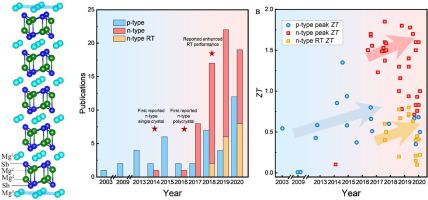Journal of Materiomics ( IF 8.4 ) Pub Date : 2021-07-29 , DOI: 10.1016/j.jmat.2021.07.004 Zhijia Han 1, 2 , Jing-Wei Li 3 , Feng Jiang 2 , Jiating Xia 2 , Bo-Ping Zhang 1 , Jing-Feng Li 3 , Weishu Liu 2, 4

|
Room-temperature thermoelectric materials provide promising solutions for energy harvesting from the environment, and deliver a maintenance-free power supply for the internet-of-things (IoTs). The currently available Bi2Te3 family discovered in the 1950s, still dominates industrial applications, however, it has serious disadvantages of brittleness and the resource shortage of tellurium (1 × 10−3 ppm in the earth's crust). The novel Mg3Sb2 family has received increasing attention as a promising alternative for room-temperature thermoelectric materials. In this review, the development timeline and fabrication strategies of the Mg3Sb2 family are depicted. Moreover, an insightful comparison between the crystallinity and band structures of Mg3Sb2 and Bi2Te3 is drawn. An outlook is presented to discuss challenges and new paradigms in designing room-temperature thermoelectric materials.
中文翻译:

室温热电材料:挑战和新范式
室温热电材料为从环境中收集能量提供了有前景的解决方案,并为物联网 (IoT) 提供免维护电源。目前可用的在1950年代发现的Bi 2 Te 3族仍然在工业应用中占主导地位,但是它具有脆性和碲资源短缺( 地壳中1×10 -3 ppm)的严重缺点。新型 Mg 3 Sb 2家族作为一种有前途的室温热电材料替代品受到了越来越多的关注。在这篇综述中,Mg 3 Sb 2的开发时间表和制造策略家庭被描绘。此外,还对 Mg 3 Sb 2和 Bi 2 Te 3的结晶度和能带结构进行了深入的比较。展望未来,讨论设计室温热电材料的挑战和新范例。











































 京公网安备 11010802027423号
京公网安备 11010802027423号